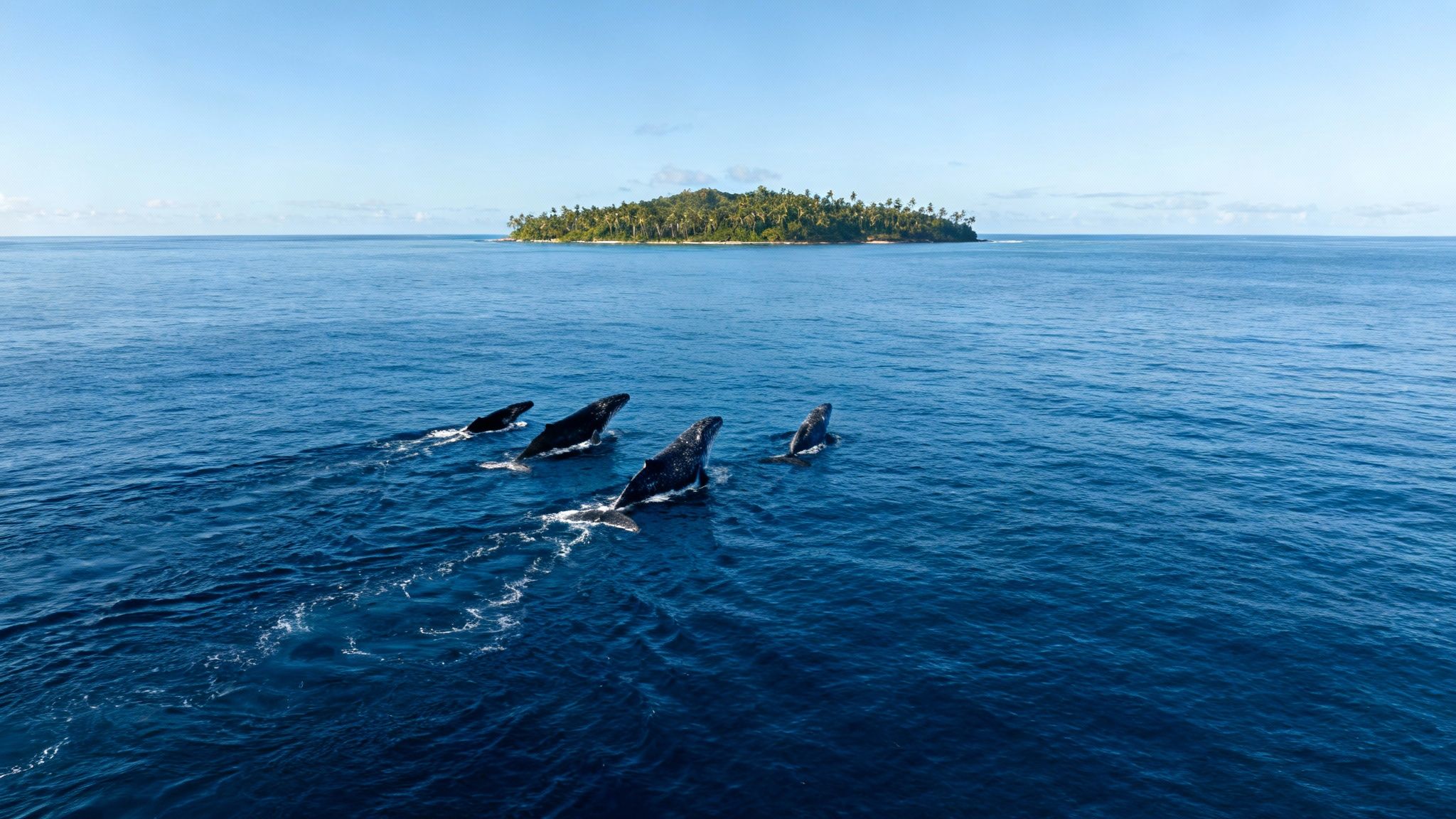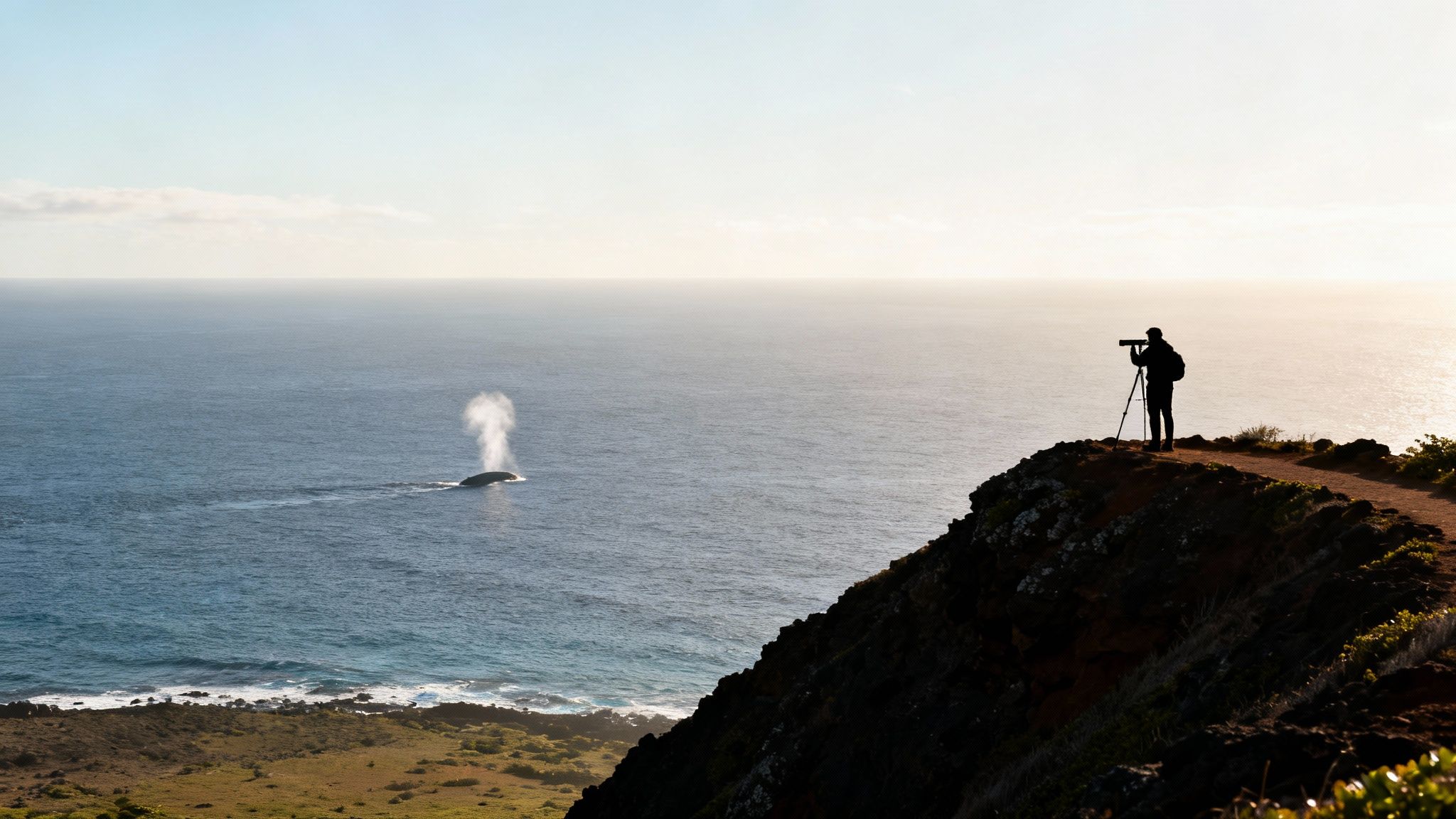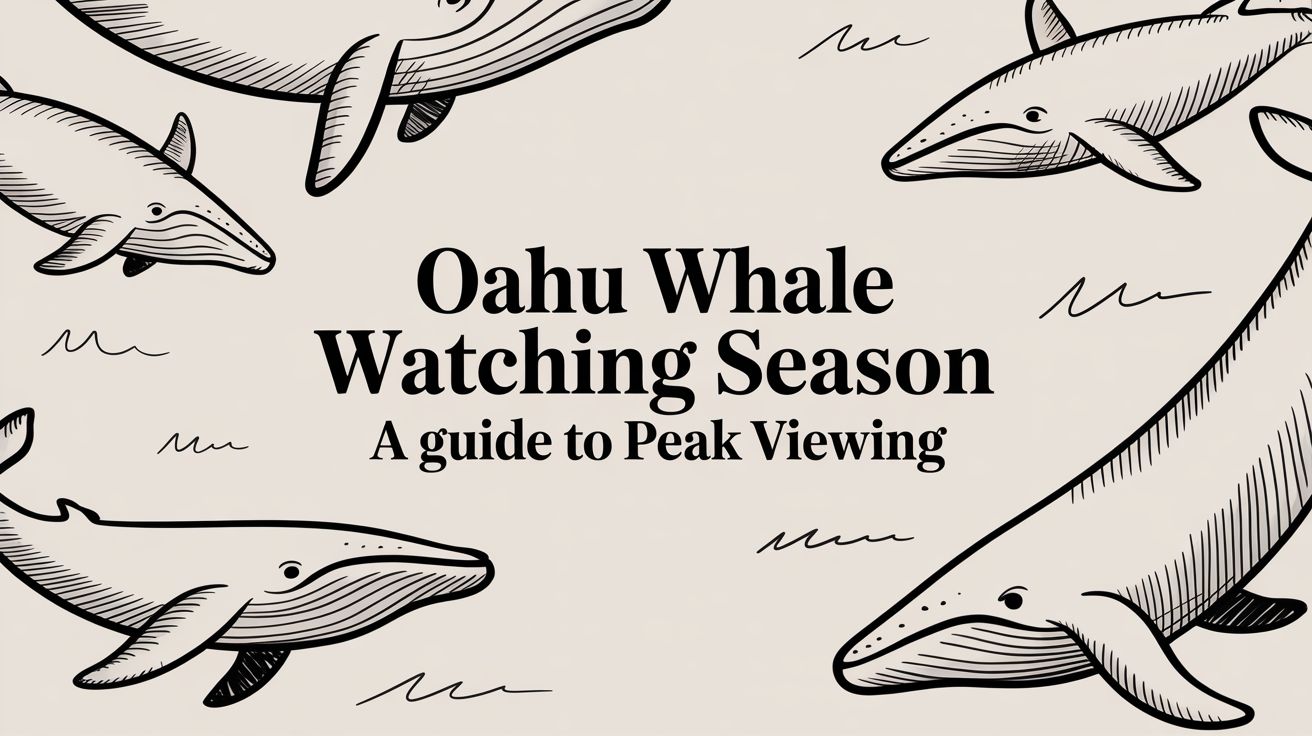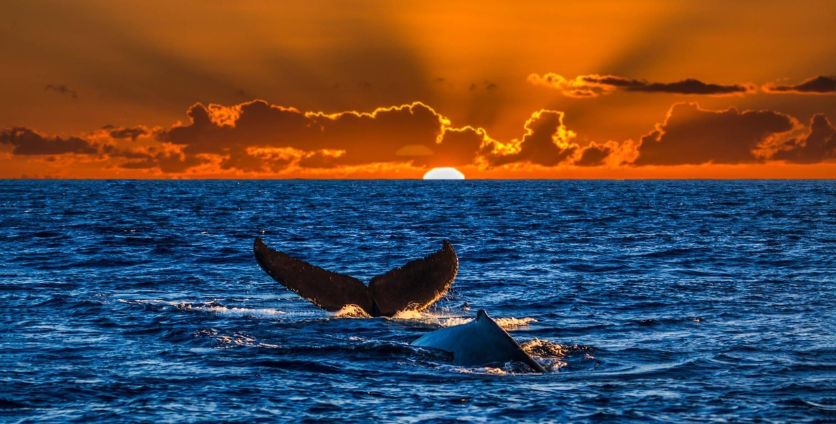Picture this: the calm, turquoise Pacific suddenly explodes as a 40-ton humpback whale throws its entire body out of the water. That's the kind of magic you can expect during the Oahu whale watching season.
If you're looking for the short answer, the season runs from December to April. For the absolute best chance at incredible sightings, you'll want to aim for the peak months of January through March. During this time, Oahu's coastline transforms into a front-row seat for one of nature's greatest shows.
Welcome to Oahu's Incredible Whale Watching Season

Every winter, an ancient and awe-inspiring migration happens just off the shores of Waikiki. These gentle giants travel thousands of miles from the frigid feeding grounds of Alaska, seeking the warm, protected waters of Hawaii to breed, give birth, and raise their newborn calves.
It's a truly spectacular annual event. To make sure you have the best possible experience, it's a good idea to go with a tour operator who really knows and respects the ocean. As the top-rated and most-reviewed snorkel company on Oahu, we at Living Ocean Tours are passionate about creating unforgettable and responsible marine adventures.
To give you a better idea of what to expect throughout the season, here’s a quick breakdown of how things typically unfold.
Oahu Whale Watching Season At a Glance
The table below summarizes the key periods, so you can easily figure out the best time for your trip.
| Month | Sighting Probability | Whale Activity |
|---|---|---|
| December | Good | The first arrivals appear. You'll often see active males competing for mates. |
| January | Excellent | The population grows, with lots of surface activity. Great for seeing breaches! |
| February | Peak | The highest concentration of whales. This is prime time to spot mothers with their calves. |
| March | Excellent | Still a very active month with plenty of mothers and calves visible. |
| April | Fair | Whales begin their journey back to Alaska, so sightings become less frequent. |
While you can see whales anytime between December and April, planning your visit for the peak months really puts you in the heart of the action when the ocean is most alive.
The Rhythm of the Season
There’s a natural flow to the whale season that’s incredible to witness. It starts with a trickle and builds into a crescendo of activity.
- Early Season (December): The first humpbacks start showing up, and the excitement builds as sightings become more consistent.
- Peak Season (January – March): This is the sweet spot. The waters are teeming with whales, and you have the best chance of seeing spectacular behaviors like breaches, tail slaps, and spy-hopping. It's also when you're most likely to see tender moments between mothers and their newborn calves.
- Late Season (April): Things start to wind down as the whales begin their long swim back to their Alaskan feeding grounds. You can still see them, but the numbers gradually decrease.
Choosing the right time to visit significantly increases your chances of a memorable encounter. Planning for the peak months puts you in the heart of the action when the ocean is most alive with activity.
Going on a whale watch is so much more than just a boat ride; it’s a chance to connect with the profound life cycle of these magnificent animals. And there's so much more to do here during this vibrant time of year. For a complete guide, check out our article on what makes winter in Honolulu so special.
Choosing a tour that respects these animals and offers expert guidance is the key to a meaningful and responsible adventure.
The Epic Journey of Hawaii's Humpback Whales

So, why do thousands of humpback whales travel an incredible 3,000 miles across the open Pacific to hang out with us in Oahu every year? It’s not just a vacation—it's one of nature's most profound journeys, a round-trip pilgrimage these magnificent animals are driven to make.
This migration is one of the longest of any mammal, taking them from the icy, food-rich waters of Alaska all the way to our warm, welcoming Hawaiian seas.
Think about leaving a kitchen full of food to go on a six-week, non-stop trek across a continent, all without eating a single bite. That's pretty much what these whales are doing. They spend their summers gorging on krill and small fish in the nutrient-dense northern seas, packing on immense blubber reserves to fuel their entire trip.
Once they get here, their focus shifts completely. Adult humpbacks don't eat at all during their Hawaiian stay. Instead, they turn all their energy toward the fundamental drives of life: mating and giving birth.
A Tropical Nursery for the Next Generation
The whole reason for this epic journey boils down to one simple, crucial factor: water temperature. While adult humpbacks have thick layers of blubber to keep them warm, their newborn calves don't. A baby whale, or keiki, is born with very little body fat, leaving it completely vulnerable in Alaska's frigid waters.
Frankly, a newborn wouldn't stand a chance in the cold. Hawaii’s shallow, protected, and warm waters—which average a comfortable 77°F (25°C)—are the perfect oceanic nursery. It’s a safe, calm place for mothers to give birth and nurse their young without the threat of predators or freezing temperatures.
This annual migration is, at its heart, a story of survival. The warm Hawaiian waters provide a safe harbor where the next generation of humpback whales can be born, grow strong, and get ready for their own first journey north.
In its first few months, a calf will drink up to 100 gallons of its mother's incredibly rich milk every single day. This helps it pack on weight fast, building the blubber layer it needs for the long swim back to Alaska. When you see a mother and her calf during the Oahu whale watching season, you're witnessing this beautiful, critical stage of life unfold right before your eyes.
The Science of Survival and Instinct
This whole migration is a finely tuned cycle, guided by pure instinct. The males usually show up first, ready to compete for mates with breathtaking shows of power, like breaching and slapping their massive tails. The females, especially those pregnant from the year before, arrive soon after, looking for quiet spots to give birth.
This annual pilgrimage is absolutely essential for the survival of the species. It ensures that the calves are born into an environment that gives them the best possible shot at life. And while they’re here, they join a vibrant ecosystem full of other incredible creatures. To get a better sense of who they're sharing the water with, check out the diverse underwater Hawaii marine life you may encounter on your visit.
When you understand the "why" behind their journey, your whole whale watching experience changes. Every spout on the horizon, every fluke that disappears into the blue—it all becomes part of a much bigger, more meaningful story of endurance, instinct, and the powerful rhythms of the natural world.
A Guide to Decoding Whale Behavior

When you're out on the water during the Oahu whale watching season, you're witnessing something far more complex than just random splashes and jumps. Each action is a piece of a conversation, a part of a story unfolding right in front of you. Learning to read these cues transforms a great boat trip into an unforgettable encounter.
Instead of just seeing a whale, you start to understand what it might be thinking or doing. With an experienced crew to point things out in real time, you get a front-row seat to one of nature’s greatest shows.
The Breathtaking Breach
The breach is the one everyone hopes to see. It’s that jaw-dropping moment a 40-ton animal hurls itself completely out of the water, landing with a splash you can hear from miles away. But it's not just for show. Marine biologists believe breaching serves a few key purposes.
- A Loud Hello: That thunderous crash sends soundwaves traveling far and wide underwater. Think of it as a long-distance call to other whales in the area.
- An Itch Scratched: Leaping out of the water could be a pretty effective way to shake off pesky parasites and barnacles that latch onto their skin.
- Showing Off: You’ll often see breaching in competitive groups, especially males trying to impress a female. It’s a raw display of power and fitness. Sometimes, though, it might just be pure joy.
Surface Slaps and Splashes
While the breach gets all the glory, humpbacks have a whole vocabulary of other surface behaviors you're more likely to see. A tail slap, also called lobtailing, is exactly what it sounds like. The whale lifts its enormous fluke high into the air and smacks it down hard on the water, creating a surprisingly loud crack. It can be a warning, a way to signal others, or even a technique to stun fish when feeding up in Alaska.
Then there's the pectoral fin slap. The whale rolls onto its side, raises a fin that can be up to 15 feet long, and slaps it over and over again. It’s another powerful way to make a lot of noise and get a message across.
Understanding these behaviors is like learning a new language. A tail slap isn't just a splash; it's a message. A breach isn't just a jump; it's a statement. Recognizing them adds a rich layer of meaning to your whale watching adventure.
A Curious Peek at Our World
Ever seen a whale slowly and deliberately lift its head straight out of the water, like a submarine periscope? That's a spyhop. The whale holds itself vertically, poking its eyes just above the surface to get a good look around.
Spyhopping is pure curiosity. The whale is actively checking out its surroundings—and that often includes your boat. It’s a quiet, powerful moment that feels like a real connection, a reminder that while we're watching them, they’re often just as interested in watching us.
How to Choose the Perfect Whale Watching Tour
Picking the right tour is what separates a nice boat ride from a truly unforgettable whale encounter. Honestly, with so many options out there, knowing what to look for makes all the difference. The boat you're on, the crew's experience, and the company's whole vibe toward the ocean—it all adds up to shape your day during the Oahu whale watching season.
Thinking about the boat itself isn't just about comfort; it's about the kind of adventure you're after. Big catamarans are incredibly stable, a huge bonus if you're worried about getting seasick. They usually have more space to roam and more amenities, which is great for families. On the flip side, a smaller boat can feel much more intimate and personal, getting you right down near the water for a totally different perspective.
But no matter the boat size, there's one thing that can take your trip from just sightseeing to a genuine learning experience: having a marine naturalist on board.
Why an Expert Guide Matters
A seasoned crew that really knows their marine biology does more than just spot whales. They give you the story behind what you're seeing, turning every spout and splash into a piece of a bigger puzzle. They can translate whale behavior in real-time, explaining why one breach is a show of dominance while a tail slap is a form of communication. That kind of insight adds a whole other layer of awe to the experience.
Here at Living Ocean Tours, our crew is genuinely passionate about Oahu's entire marine world. Our Waikiki Whale Watching Tour isn't just about seeing whales; it's about understanding them. We're sticklers for responsible viewing guidelines, making sure our presence never stresses these incredible animals. We believe a great tour respects the ocean and its inhabitants—that's the principle behind every single trip we run.
What to Look for in a Tour Operator
When you're weighing your options, a few key things can help you lock in a quality, responsible trip.
- Experienced Crew: Look for companies that talk up the expertise of their guides and captains. That local knowledge is gold when it comes to finding whale pods.
- Responsible Practices: Go with operators who are open about following federal and state viewing laws, like keeping a safe 100-yard distance.
- Vessel Comfort and Safety: Make sure the boat looks well-maintained and has all the necessary safety gear. A quick scan of reviews for comments on cleanliness and comfort can tell you a lot.
- Educational Focus: The best tours want you to leave knowing more than when you arrived. If they have a hydrophone on board to listen to whale songs, that's a huge bonus for a truly immersive trip.
Data from the Sanctuary Ocean Count really drives home how important Oahu is during peak season. Back in January 2022, observers tallied around 107 humpback whales off Oahu. That blew the other islands out of the water, with Kauai at 59 and the Big Island at 19. That concentration of whales makes choosing a great tour here even more rewarding. You can dig into more of those numbers in this detailed whale season overview.
Your choice of tour operator directly impacts not only your experience but also the well-being of the whales. Supporting companies that prioritize education and conservation helps protect these gentle giants for future generations.
Making a smart choice is the first step toward an amazing day. For a little more guidance, our deep-dive article on how to choose the best boat tours in Honolulu has extra tips that work for any trip on the water. By putting expertise and respect for the ocean first, you can make sure your whale watching tour is a highlight of your time in Hawaii.
Top Spots for Whale Watching From Shore

While getting out on a boat gives you that incredible, up-close perspective, you don’t always have to leave solid ground to witness the magic of whale season. Oahu's dramatic coastline is dotted with elevated lookouts perfect for spotting a distant breach or the telltale spout of a humpback.
For anyone who prefers a land-based adventure, a little patience and a decent pair of binoculars can lead to some truly unforgettable sightings. It’s a totally different vibe—more meditative and set against Oahu’s jaw-dropping landscapes. This is a fantastic option if you have very young kids, are sticking to a budget, or just want to spend a quiet morning scanning the horizon for these gentle giants.
Makapuu Point Lighthouse Trail
If there's one spot locals and visitors swear by for shore-based viewing, it’s the Makapuu Point Lighthouse Trail. This paved, moderately challenging hike sits on the easternmost tip of Oahu and rewards you with absolutely breathtaking panoramic views of the Kaiwi Channel—a veritable highway for migrating humpbacks.
Your biggest advantage here is the elevation. From the trail, you can scan a huge expanse of the Pacific, making it much easier to catch the first signs of whale activity. Keep an eye out for the "blow," that misty spray that erupts when a whale surfaces to breathe. On a calm day, it can hang in the air for a few seconds.
Halona Blowhole Lookout
Just a quick drive from Makapuu, the Halona Blowhole Lookout is another fantastic and super-accessible viewpoint. While the lookout is famous for its geyser-like water spout, during whale season, the real show is often happening just offshore. The deep blue waters here are a common route for whales traveling along the southern coast.
You're closer to sea level here than at Makapuu, so bringing binoculars is a must if you want a better look. This spot is perfect for a quick stop, since you can often see activity right from the parking area. Pro tip: get there early in the morning to beat the crowds and enjoy calmer ocean conditions, which makes spotting whales much easier.
Don't underestimate the power of a good pair of binoculars. They can transform a distant, unidentifiable splash into a clear view of a massive fluke or a pectoral fin slapping the water, bringing the experience to life from hundreds of yards away.
Other Shoreline Gems
Beyond these two hotspots, several other areas offer a great chance to see whales from land.
- Diamond Head Lookout: The pull-offs along Diamond Head Road, just east of Waikiki, offer elevated views where you can sometimes catch whales passing by.
- Kaena Point State Park: For a wilder, more remote setting, head to the island's far western tip. The rugged coastline here is a great place to whale watch away from the crowds.
- North Shore Beaches: During peak season, it’s not unusual to spot spouts and breaches from famous beaches like Sunset Beach or Waimea Bay, especially when the seas are calm.
While you're out exploring these beautiful coastal spots, keep an eye out for other marine life, too. The same waters that draw in the whales are also home to our beloved sea turtles. You can learn more about where to see turtles in Oahu in our other guide. Spotting both a breaching whale and a surfacing turtle in the same day is a truly special Hawaiian experience.
Protecting the Whales Through Responsible Viewing
Seeing a 40-ton humpback whale launch itself out of the water is a moment that sticks with you forever. But it's a privilege, and it comes with a serious responsibility. During Oahu's whale watching season, we're just temporary guests in their nursery—a critical space for mothers and their brand-new calves. How we act out there on the water has a direct impact on their well-being.
Following responsible viewing practices isn’t just a nice idea; it’s the law. Both federal and state regulations are in place to protect these amazing animals from being disturbed by us. The single most important rule to remember is that all boats must stay at least 100 yards away from humpback whales. To put that in perspective, think of the length of a football field.
Why Distance Matters
That 100-yard buffer zone is there for a few very important reasons. Getting too close can cause a lot of stress for the whales, interrupting essential behaviors like nursing, resting, and mating. Imagine a mother trying to teach her calf how to survive—a boat coming in too close can easily separate the pair or scare them off, forcing them to burn precious energy they need to thrive.
When we view them respectfully from a distance, the whales see us as a neutral part of the scenery, not a threat. This approach doesn't just protect them; it usually leads to a much better and more natural viewing experience for everyone on board.
By choosing tour operators who put the whales' welfare ahead of getting a closer shot, you're actively helping with their conservation. Ethical tourism is what ensures these gentle giants feel safe enough to keep returning to Hawaiian waters year after year.
Choosing an Eco-Conscious Operator
The best way to make sure your experience is a responsible one is to go with a tour company that makes conservation a real priority. Eco-conscious operators like Living Ocean Tours build their whole philosophy around respecting marine life. They get that a truly incredible encounter is one that happens on the whales’ own terms.
Here are a few simple things you can do to be a responsible whale watcher:
- Bring a Zoom Lens: Instead of pushing the captain to get closer, use a camera with a good zoom lens or a pair of binoculars to get that detailed view.
- Keep Your Voice Down: Loud noises can be startling. When whales are nearby, it’s best to keep a calm and quiet vibe on the boat.
- Never Ask to Chase: A reputable captain will never pursue or circle around whales. They know how to position the boat to let the whales pass by on their own, without making them feel cornered.
By keeping these simple but powerful practices in mind, you're doing your part to protect the humpback whales of Oahu, making sure they continue to thrive for generations to come.
Common Questions About Oahu Whale Watching
To help you put the final touches on your travel plans, we’ve rounded up some of the most common questions we get about the Oahu whale watching season. Getting clear, straightforward answers makes it so much easier to plan an incredible adventure on the water.
What Is the Absolute Best Month to See Whales in Oahu?
While the whole season from December to April is fantastic, February is undeniably the peak month. This is when the highest concentration of humpback whales is in Hawaiian waters, hands down.
Think of it as the sweet spot. In February, you have the best odds of seeing a wide range of behaviors, from spectacular breaches to mothers with their newborn calves—a truly special sight. January and March are excellent runners-up, but February is when the action really peaks.
Are Whale Sightings Guaranteed on Tours?
This is a really important question, and the honest answer is no. Since we're dealing with wild animals in their natural habitat, no tour operator can 100% guarantee a sighting on any given day. Nature is beautifully unpredictable, and that's part of the magic.
That said, reputable tour companies have experienced crews who know the local waters and whale patterns inside and out, making sightings highly likely during the peak season. Most will also offer a "whale guarantee," which means if you don't see any whales, you can come back for another tour free of charge. Just be sure to check the individual company’s policy.
What Should I Bring on a Whale Watching Tour?
Packing a small bag with a few key items will make your time on the water much more comfortable. Here’s a quick checklist to get you ready:
- Sun Protection: The Hawaiian sun is no joke, even when it's cloudy. Pack some reef-safe sunscreen, a wide-brimmed hat, and sunglasses.
- Camera or Binoculars: A camera with a decent zoom lens or a good pair of binoculars will help you get a closer look without disturbing the whales.
- Light Jacket: It can get breezy and a bit cool out on the ocean, especially on morning tours. A light windbreaker or jacket is always a good idea.
- Seasickness Medication: If you're prone to motion sickness, it's smart to take medication beforehand as a precaution. Better safe than sorry!
For more detailed packing tips and other common queries, you can find a ton of helpful info on our Frequently Asked Questions page.
Can You See Whales From Waikiki Beach?
It's technically possible to spot a distant spout or breach from the shores of Waikiki on a crystal-clear day, but it's extremely rare and definitely not something to count on. The whales are almost always much farther offshore.
For an immersive, up-close, and truly unforgettable encounter, nothing beats a dedicated boat tour that takes you out to where the whales are most active.
Ready to witness the magic of the Oahu whale watching season for yourself? Living Ocean Tours offers expert-guided adventures that prioritize responsible viewing and unforgettable experiences. Book your Waikiki Whale Watching Tour today and create memories that will last a lifetime.




